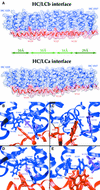Clathrin light and heavy chain interface: alpha-helix binding superhelix loops via critical tryptophans
- PMID: 12426379
- PMCID: PMC137186
- DOI: 10.1093/emboj/cdf594
Clathrin light and heavy chain interface: alpha-helix binding superhelix loops via critical tryptophans
Abstract
Clathrin light chain subunits (LCa and LCb) contribute to regulation of coated vesicle formation to sort proteins during receptor-mediated endocytosis and organelle biogenesis. LC binding to clathrin heavy chain (HC) was characterized by genetic and structural approaches. The core interactions were mapped to HC residues 1267-1522 (out of 1675) and LCb residues 90-157 (out of 228), using yeast two-hybrid assays. The C-termini of both subunits also displayed interactions extending beyond the core domains. Mutations to helix breakers within the LCb core disrupted HC association. Further suppressor mutagenesis uncovered compensatory mutations in HC (K1415E or K1326E) capable of rescuing the binding defects of LCb mutations W127R or W105R plus W138R, thereby pinpointing contacts between HC and LCb. Mutant HC K1415E also rescued loss of binding by LCa W130R, indicating that both LCs interact similarly with HC. Based on circular dichroism data, mapping and mutagenesis, LCa and LCb were represented as alpha-helices, aligned along the HC and, using molecular dynamics, a structural model of their interaction was generated with novel implications for LC control of clathrin assembly.
Figures







References
-
- Bogan A.A. and Thorn,K.S. (1998) Anatomy of hot spots in protein interfaces. J. Mol. Biol., 280, 1–9. - PubMed
-
- Brodsky F.M., Galloway,C.J., Blank,G.S., Jackson,A.P., Seow,H.-F., Drickamer,K. and Parham,P. (1987) Localization of clathrin light-chain sequences mediating heavy-chain binding and coated vesicle diversity. Nature, 326, 203–205. - PubMed
-
- Brodsky F.M., Hill,B.L., Acton,S.L., Näthke,I., Wong,D.H., Ponnambalam,S. and Parham,P. (1991) Clathrin light chains: arrays of protein motifs that regulate coated vesicle dynamics. Trends Biochem. Sci., 16, 208–213. - PubMed
-
- Brodsky F.M., Chen,C.-Y., Knuehl,C., Towler,M.C. and Wakeham,D.E. (2001) Biological basket weaving: formation and function of clathrin-coated vesicles. Annu. Rev. Cell Dev. Biol., 17, 517–568. - PubMed
Publication types
MeSH terms
Substances
Grants and funding
LinkOut - more resources
Full Text Sources
Molecular Biology Databases
Research Materials

